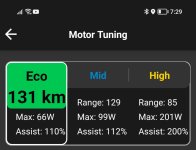On topic: TQ Motor Settings
Many here have been riding TQ HPR50motors for good while, long enough to know what motor settings work best for them on the road. What settings have you settled on?
Mine are broadly rounded:
Eco 100W, 100%, Rapid... Mid 200W ,200%, Gradual... High 300W, 200%, Gradual.
(I would drop Mid to 150% if I could sustain more than 100W, but my heart only tolerates short bursts above that, so I get my maximum sustainable 200W assistance on Mid, and rare sub-minute 250-300W boosts from High.)
What settings have you settled on?
Off topic: Rattling Noise
Posted this on a new Trek thread but no response. It likely means that it's not a problem for other Domane+ riders, but thought it worthwhile to give it a try here.
Rattling noise from inside my Trek Domane+ SLR6 frame, on even slightly rough pavement, is spoiling my rides.
Possible causes include 1) loose internal wire connectors banging against the frame, 2) loose nut or other bit of hardware bouncing around somewhere, or 3) Something else??
Looking for the forum's feedback, particularly on 1). Anyone experience similar rattling noise?
I'm prepared to have a Trek shop remove the motor, battery and headset and have a good look inside the frame, but it would be good to have a better sense of what to target.
Regards and thanks, Rob.


